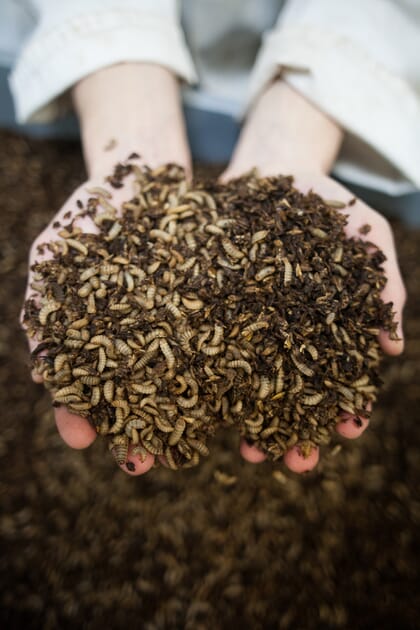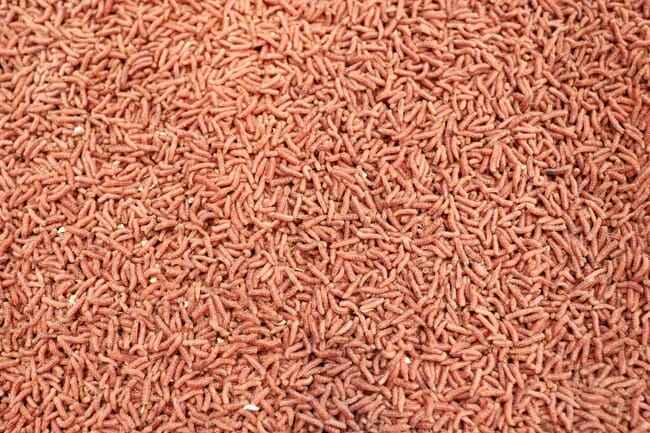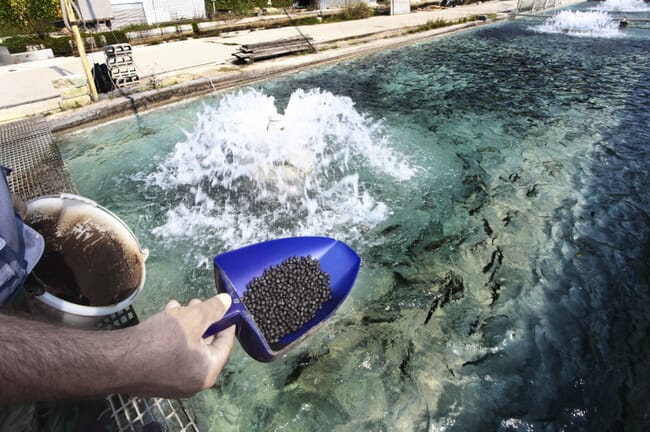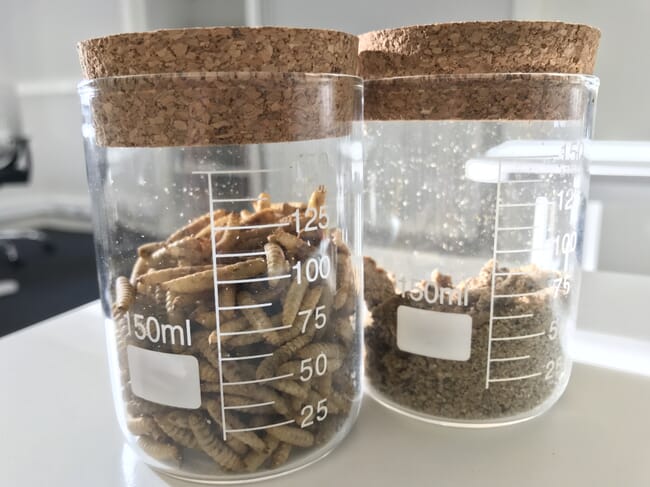
A recent systematic review published in Reviews in Aquaculture has evaluated the environmental consequences of insect farming and insect-based diets in aquaculture. The results suggest that the sustainability picture of insect meals and oils isn’t as straightforward as it initially appears.
The researchers found that insect farming was associated with fewer land inputs than conventional ingredients but came with greater energy use and a larger carbon footprint. For some environmental indicators, insect meal and conventional aquafeed ingredients had comparable results. This suggests that there isn’t a huge environmental gain in adopting insect meals – the industry’s footprint could remain largely unchanged as it adopts alternative ingredients.
Though this finding makes the insect sector’s sustainability pitch more complex, the researchers noted that the industry has ample room to innovate and grow. New technologies, emerging research and investment are on the insect sector’s side. These improvements in production efficiency and research efforts could reduce the insect industry’s greenhouse gas emissions and make it more competitive with conventional ingredients. In time, insect meals and oils could generate a smaller carbon footprint and potentially reduce aquaculture’s total environmental impact.
Moving insect meal beyond the larval stage
Insect meals and oils are generating a steady media buzz as an alternative protein and lipid source for aquafeeds. Insect meals – usually derived from black soldier flies, mealworms or houseflies – have a strong nutrition profile, are commercially feasible and can be created at scale. Previous research has shown that marine and freshwater finfish can consume insect ingredients during the production cycle without experiencing growth or performance deficits.

Insect meals also come with a compelling sustainability pitch. Opting for insects in lieu of marine ingredients in aquafeed means that producers can reduce their fish-in-fish-out measures, addressing one of the sector’s sustainability woes. Other studies have found that insect farming uses fewer land and water resources than soy – another key aquafeed ingredient. The fact that some insect species feed off waste products and upcycle them into digestible proteins and fats is an additional benefit.
At face value, it appears that including insect meals in aquafeed could substantially decrease its environmental footprint – but this hasn’t been fully quantified by researchers. There isn’t a lot of published literature on the full environmental consequences of insect meal diets for aquaculture. The industry is still producing small volumes of feed ingredients and has not achieved an economy of scale – making production more expensive and less efficient than other ingredient options. There also isn’t a side-by-side comparison of insect ingredients vs fishmeal and fish oil on environmental indicators. This leaves many sustainability questions unresolved.
The complexity of measuring environmental impacts
Most conversations about environmental sustainability and aquafeed focuses on inclusion levels for fishmeal and fish oil – but this presents only a partial picture. The current push to reduce or even replace marine ingredients with alternative feed sources isn’t necessarily a silver bullet for sustainability. Each alternative ingredient – including insect-based ones – comes with its own water, land and energy use footprint. It also comes with its own global warming potential. Researchers have to capture all of this complexity before they can say that a feed ingredient environmentally friendly.

© CAT
For this study, the researchers conducted a systematic review of life cycle analyses (LCAs) on ingredients derived from three insect species: black soldier fly (Hermetica illucens), mealworm (Tenebrio moilitor) and housefly (Musca domestica). LCAs evaluate the environmental impacts of a product throughout its lifespan and also measure the systems that created it – from raw materials, processing and eventual disposal.
As part of the systematic review, the LCAs measured the global warming potential, energy use, land use, water use, acidification and eutrophication associated with insect-derived ingredients. The researchers also evaluated the benefit of replacing marine ingredients with insect meals and insect oil using the economic fish-in-fish-out measure (eFIFO). This helped quantify the environmental consequences of using insect meal as an aquafeed ingredient – and see how it stacks up against fishmeal and fish oil.
How do insect-based ingredients compare to marine ones?
The review found that insect meals used fewer land resources than plant-based ingredients like soy. Within the insect category itself, houseflies required fewer land inputs than mealworms. When comparing land use efficiency between insect production, fishmeal and single-cell proteins, the researchers found that all three industries were roughly comparable. The researchers also learned that insect-based ingredients were associated with greater energy use and had a larger carbon footprint when compared to conventional marine ingredients. These measures were especially pronounced when looking at greenhouse gas emissions and global warming potential.
In general, the review found that replacing fishmeal with other protein sources was associated with increased global warming potential, energy use, water use, acidification and eutrophication. When taking a closer look at the indicators, the researchers learned that insect meals and fishmeal had comparable environmental impacts. In many cases, insect ingredients’ gains in one area – namely land use – were offset by deficits in another – like solid nitrogen waste levels.
In this study, fishmeal had the lowest impact across the experimental categories – the only area where it fell behind was in energy use. Alternative aquafeed ingredients appeared to exert an enormous impact on global warming potential, energy use, water use, acidification and environmental eutrophication. At this stage, opting for innovative aquafeed ingredients wouldn’t immediately translate into an environmentally friendly end-product.
Calculating the replacement potential
One area where insect ingredients excelled was in their ability to reduce aquafeed’s eFIFO measures. The researchers found that this replacement potential was feasible across multiple species. If this finding is applied broadly, it means that choosing insect meals in lieu of fishmeal could make the aquaculture sector a net producer of fish instead of a net consumer. Adopting insect meals and oils could, “play an essential role in conserving finite forage fish resources while meeting the increasing demand for aquafeed protein [and] lipid sources,” according to the experimental analysis.

However, the researchers stressed that fully replacing marine ingredients with insect meals would require nutritional fortification – especially for amino acids and essential fatty acids. The nutrition profile of insect meals varies depending on the quality of the insect feed and processing method. Lipid levels for insect oil could fall between 16.6 percent and 40.3 percent. This needs to become more consistent for it to accomplish a one-to-one swap.
In the near term, blending insect ingredients with microalgae-derived materials would make alternative feed sources nutritionally comparable to fishmeal. It would also, “allow the inclusion of higher proportions of insect ingredients [in aquafeed], thus reducing dependence on marine fish resources,” the researchers said.
The devil’s in the details
Though elements of the review put insect-based ingredients in a positive light, the authors note that the insect farming industry needs to make drastic improvements to follow through on its sustainability pitch and be competitive with marine ingredients.
According to the researchers, the sector needs to become more efficient and develop better substrates for its insects. Fly farming’s biggest environmental drain comes from the insects’ food source, or substrate – and each food source carries environmental ramifications.
In this review, distillers’ grains – which are already used as feed in the livestock industry – appeared to be a promising food source for houseflies and black soldier flies. But the grains aren’t always environmentally efficient and drove much of the insect industry’s water use. This means that adopting a high-quality substrate will increase the sector’s environmental footprint. Insect producers will need to balance the trade-off between nutritional gains and environmental impacts as the industry develops.
Similarly, the literature indicates that feeding insects food waste and manure – the substrates that could move the industry towards a “circular economy” – is only workable in some cases. Mealworms cannot metabolise manure and feeding food waste to animals is subject to strict regulations, especially in the European Union. Insects also need consistent feed inputs to achieve competitive lipid and protein profiles. This means that relying on wastes with variable nutrient content may not be a workable strategy.

The industry still needs to identify the best substrate for rearing insects and work to quantify its environmental consequences. This would give the industry a more accurate picture of its sustainability credentials and allow protein and lipid levels in insect meals to become more consistent.
The challenges of early-stage innovation
Though this presents a complex picture, the researchers were quick to point out that the environmental impacts of insect-based diets are influenced by multiple components. They also noted that the insect industry has huge potential for improvement. This stands in contrast with the marine ingredients sector. Forage fish stocks are a finite resource, and the sector is already operating at peak efficiency. Insect farming is only starting to come online and is still producing small volumes. Marine ingredients might be eclipsed if the insect industry achieves economies of scale and operates more efficiently.
The researchers say that insect-rearing facilities need to be optimised. If the facilities are constructed and operate with minimal wastage and high efficiency, the environmental impact measures for insect-based ingredients will improve dramatically. Land use metrics could reduce if facilities scale up and take advantage of vertical production, multi-level shelves or stackable boxes. Access to renewable energy could cut impact measures by 25 percent. This would offset the facilities’ environmental burden and make heating and drying costs more reasonable. The researchers also suggest building insect facilities in equatorial climates to reduce heating expenses.

Focusing on the facilities’ construction and location, while also using optimal substrates for the insects would bring much-needed progress to the sector. The industry is winning huge investments and is increasing its production volumes – improving on these metrics could spur further investment and innovation. It could also make its on-paper environmental pitch more concrete.
In the researchers’ view, insect meals and oils probably won’t be the sole ingredients the sector relies on as it formulates sustainable aquafeed. It’s more likely that the industry will use a combination of alternative protein and lipid sources that have low environmental impacts. This will let feed formulators be strategic about their ingredient selections and account for potential innovations across the broader alternative ingredients sector.




